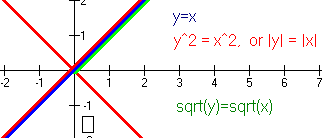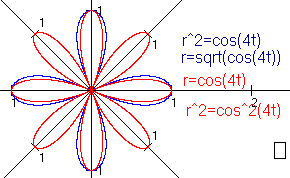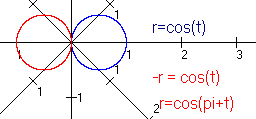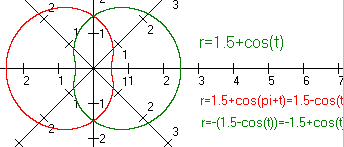Some
Examples related to the 4/9/02 lecture on polar graphs.
Some of you raised interesting questions about the effect of
minus signs and square roots (etc) on basic polar graphs. I hope
these examples help clear those up, though there are surely more
questions that you can ask, and I hope you will explore some more
on your own. I created these with MathGV (see my help page for
the link to this freeware).
Notes: 1) Please ignore the little rectangles accidentally
appearing near some of the graphs. 2) I printed equations in the
same color as their graphs - two equations of the same color have
the same graph. 3) y^2 means "y squared" and
cos^2(4t) means "cos(4t) squared".
 Here are some
familiar graphs. The thin dark blue line is y = x. If you square
both sides (y^2 = x^2), you include the possibility of y = -x.
So, you "create new solutions" and get a bigger graph
(the red "X"). On the other hand if you take square
roots of both sides of y = x, you "destroy some
solutions" (you prevent negative x's and y's) and get a
smaller graph (the green line).
Here are some
familiar graphs. The thin dark blue line is y = x. If you square
both sides (y^2 = x^2), you include the possibility of y = -x.
So, you "create new solutions" and get a bigger graph
(the red "X"). On the other hand if you take square
roots of both sides of y = x, you "destroy some
solutions" (you prevent negative x's and y's) and get a
smaller graph (the green line).
NOTE: Some of these lines should be on top of each other. I
had to play with the widths of the lines (etc) so you can see
them.
NOTE: What happens if you take the square root of both sides
of y^2 = x^2?
 This is a polar
version of the previous example. The original graph is the red
one; r = cos(4t). Squaring both sides does not create new points
this time [because -r = cos(4t) has the same graph as r =
cos(4t). The next example explains this more]. Taking a square
root of cos(4t) [the blue graph] does two things:
This is a polar
version of the previous example. The original graph is the red
one; r = cos(4t). Squaring both sides does not create new points
this time [because -r = cos(4t) has the same graph as r =
cos(4t). The next example explains this more]. Taking a square
root of cos(4t) [the blue graph] does two things:
- It destroys some solutions, such as when t = pi/4 [we
can't take sqrt(-1) etc] and
- It distorts the four remaining petals. [they get bigger,
because (for example) sqrt(1/4)>1/4 etc]
 The blue graph, r
= cos(t) is familiar. Putting a minus sign on the r has the
effect of rotating every point 180 degrees around the origin,
giving us the red graph. We get the same effect by adding pi to
the angle (or subtracting pi from it). In fact, cos(pi+t) = -
cos(t). This changes graphs like r = cos(3t) but not graphs like
r = cos(4t).
The blue graph, r
= cos(t) is familiar. Putting a minus sign on the r has the
effect of rotating every point 180 degrees around the origin,
giving us the red graph. We get the same effect by adding pi to
the angle (or subtracting pi from it). In fact, cos(pi+t) = -
cos(t). This changes graphs like r = cos(3t) but not graphs like
r = cos(4t).
NOTE: r = sqrt(cos(t)) looks about the same as the blue
circle; some solutions are destroyed, but because of retracing,
you don't really notice this.
 This example
combines the ideas above. The original graph is the green
limacon; r = 1.5 + cos(t). Changing to "-cos(t)"
rotates the graph (as discussed above) and gives the red graph.
Multiplying either side by -1 rotates the graph again, taking
us back to the green graph.This explains why -1.5 + cos(t) has
the same shape as +1.5 + cos(t).
This example
combines the ideas above. The original graph is the green
limacon; r = 1.5 + cos(t). Changing to "-cos(t)"
rotates the graph (as discussed above) and gives the red graph.
Multiplying either side by -1 rotates the graph again, taking
us back to the green graph.This explains why -1.5 + cos(t) has
the same shape as +1.5 + cos(t).
NOTE: Practice drawing a lot of graphs like these using
pencil, paper [and maybe a non-graphing
calculator]. You will learn shortcuts and important patterns this
way, better than just reading/hearing about them. Later, you can
use graphing calculators and/or computers for more speed and
accuracy.
 Here are some
familiar graphs. The thin dark blue line is y = x. If you square
both sides (y^2 = x^2), you include the possibility of y = -x.
So, you "create new solutions" and get a bigger graph
(the red "X"). On the other hand if you take square
roots of both sides of y = x, you "destroy some
solutions" (you prevent negative x's and y's) and get a
smaller graph (the green line).
Here are some
familiar graphs. The thin dark blue line is y = x. If you square
both sides (y^2 = x^2), you include the possibility of y = -x.
So, you "create new solutions" and get a bigger graph
(the red "X"). On the other hand if you take square
roots of both sides of y = x, you "destroy some
solutions" (you prevent negative x's and y's) and get a
smaller graph (the green line).  This is a polar
version of the previous example. The original graph is the red
one; r = cos(4t). Squaring both sides does not create new points
this time [because -r = cos(4t) has the same graph as r =
cos(4t). The next example explains this more]. Taking a square
root of cos(4t) [the blue graph] does two things:
This is a polar
version of the previous example. The original graph is the red
one; r = cos(4t). Squaring both sides does not create new points
this time [because -r = cos(4t) has the same graph as r =
cos(4t). The next example explains this more]. Taking a square
root of cos(4t) [the blue graph] does two things:  The blue graph, r
= cos(t) is familiar. Putting a minus sign on the r has the
effect of rotating every point 180 degrees around the origin,
giving us the red graph. We get the same effect by adding pi to
the angle (or subtracting pi from it). In fact, cos(pi+t) = -
cos(t). This changes graphs like r = cos(3t) but not graphs like
r = cos(4t).
The blue graph, r
= cos(t) is familiar. Putting a minus sign on the r has the
effect of rotating every point 180 degrees around the origin,
giving us the red graph. We get the same effect by adding pi to
the angle (or subtracting pi from it). In fact, cos(pi+t) = -
cos(t). This changes graphs like r = cos(3t) but not graphs like
r = cos(4t).  This example
combines the ideas above. The original graph is the green
limacon; r = 1.5 + cos(t). Changing to "-cos(t)"
rotates the graph (as discussed above) and gives the red graph.
Multiplying either side by -1 rotates the graph again, taking
us back to the green graph.This explains why -1.5 + cos(t) has
the same shape as +1.5 + cos(t).
This example
combines the ideas above. The original graph is the green
limacon; r = 1.5 + cos(t). Changing to "-cos(t)"
rotates the graph (as discussed above) and gives the red graph.
Multiplying either side by -1 rotates the graph again, taking
us back to the green graph.This explains why -1.5 + cos(t) has
the same shape as +1.5 + cos(t).